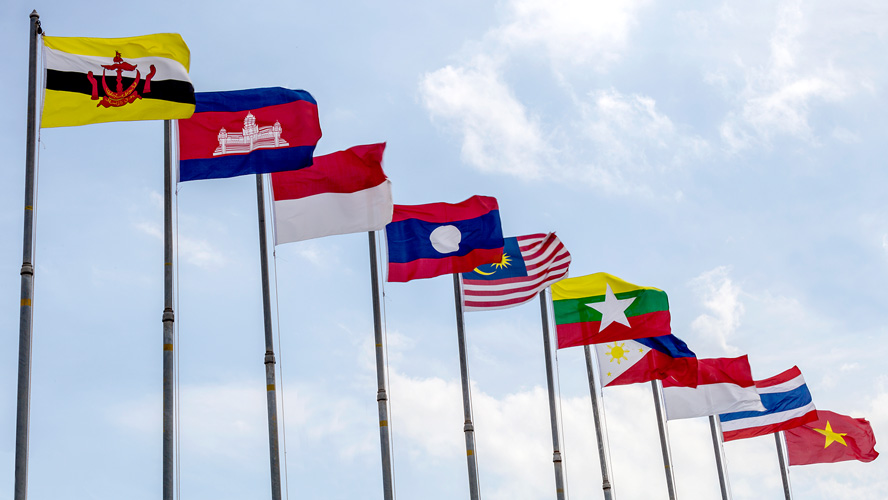
Global economic sentiment seems buoyant as international institutions and experts forecast a positive outlook for 2018. The World Bank recently reported that it expects the global economy to grow stronger than the anticipated 3.1 percent, with the acceleration of more than half of economies.
According to a research report by the Global Business Policy Council, it is the first time since the Global Financial Crisis (GFC) that the global economy is on a synchronous upswing. The positive outlook comes as the global economy experiences a cyclical recovery, reflecting a general increase in investment, manufacturing activity and trade.
Dr Razeen Sally, Visiting Associate Professor at the Lee Kuan Yew School of Public Policy, believes that this upward trend is good news for trade-dependent economies, particularly in the ASEAN region, as the increase in international trade would make headway for more fixed investment, high manufacturing production translating to increased import and export in the global supply chains and higher rates of growth in services. Markets in the ASEAN region have grown steadily at a rate of 5% over the past few years; an indication of the global broad-based recovery.
Echoing these sentiments at the Regional Outlook Forum was Mr Manu Bhaskaran, Partner at Centennial Group International, a global and leading strategic advisory firm.
Factors that threaten economic growth
Albeit a bullish outlook, the prospects for recovery only seem to be plausible for the short to medium term. Dr Sally and Mr Manu pointed out that some macroeconomic trends could affect the sustainability of this recovery in the long-term.
On an international scale, major powers have retreated from globalisation, giving rise to protectionist policies that could impede trade facilitation and limit cross-border flow of goods, services, capital and people. Trump's America's First strategy and UK's Brexit from the European Union (EU) are two glaring signals of this phenomenon. Mr Manu believes that the global trade regime is under threat from these rising protectionist sentiments. He cited a possible situation where U.S. frustration over its impotence to stop North Korean nuclear developments could spill over into a deterioration in U.S.-China ties with possible implications for trade protectionism.
These protectionist measures have arisen in light of the financial imbalances in some major economies. For instance, according to the Financial Times, under the Trump administration, the U.S. have embarked on efforts like re-negotiating the North American Free Trade Agreement (NAFTA) with Canada and Mexico, and a separate trade agreement with South Korea. These initiatives are aimed at bringing manufacturing jobs back to the U.S., while lowering its deficit with those countries. These measures can have major implications to the global trade system.
One other key example of a financial imbalance in a major economy, as Dr Sally pointed out, is the debt crisis in China. As a result of cheap credit and ultra-easy monetary policies, China's debt accounts for 250% of its Gross Domestic Product (GDP). As the world's second largest economy, China's debt crisis raises another question to the long-term economic repercussions to the global economy.
Domestically, the sustainability of the economies is dependent on the country's productivity. Interestingly, while there has been an upsurge in the global economy, the productivity index has reflected a slowdown. Dr Sally highlights that the downward trend in productivity will continue to persist. According to a report by the Global Business Policy Council, the total factor productivity growth is projected to be around 1.2 percent through 2022, which is less than half of the 2.7 percent average growth in the years prior to the GFC. This slowdown is caused by a wide range of issues from low investments in business, inadequate infrastructure spending, ageing workforce, to slow expansion of global value chains. With this trend, mid and long-term growth could be affected. In order to eschew from the risks of lower productivity, policymakers need to invest in infrastructure, skills upgrading and R&D to boost productivity growth.
Maintaining growth in Southeast Asia
Policy makers around the world need to be aware of the trends in the macroeconomic environment, and cooperate in their agreements to resolve these issues together to sustain the global recovery in the long-term. In the ASEAN region, structural reforms and multilateral trade agreements are important to deal with these challenges as well.
In recent years, there has been a proliferation of international trade agreements, including the Trans-Pacific Partnership (TPP), Comprehensive and Progressive Agreement for Trans-Pacific Partnership (CPTPP), and Regional Comprehensive Economic Partnership (RCEP). Dr Sally believes that it is important for countries to be involved in these pro-market, pro-trade, and pro-globalisation initiatives to contain protectionism and accelerate liberalisation. Collectively, this would put the region in a good position to sustain its economic recovery.
Conclusion
While the general outlook is positive, and growth in ASEAN has been sustained over the past few years, policy makers in the region should not rest on their laurels. The economic growth is part of a cyclical recovery, and to sustain this growth in the long-term, structural reforms and multilateral trade facilitation initiatives are critical to mitigate the risks of a downfall. These reforms and cross-border collaborations would also increase business opportunities and income gains, resulting in overall economic growth.
This article was written as an event coverage piece for the Regional Outlook Forum, held at the Shangri-La Hotel on 9 January 2018.